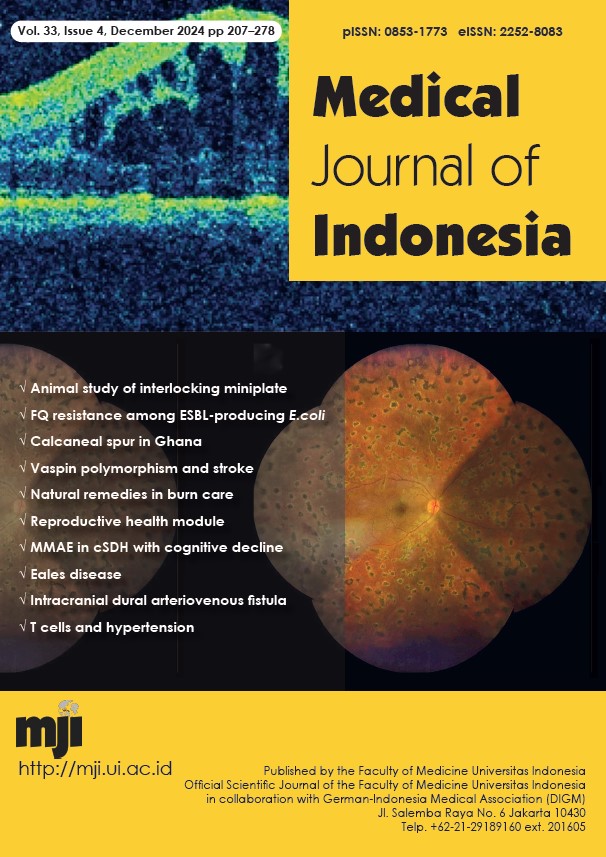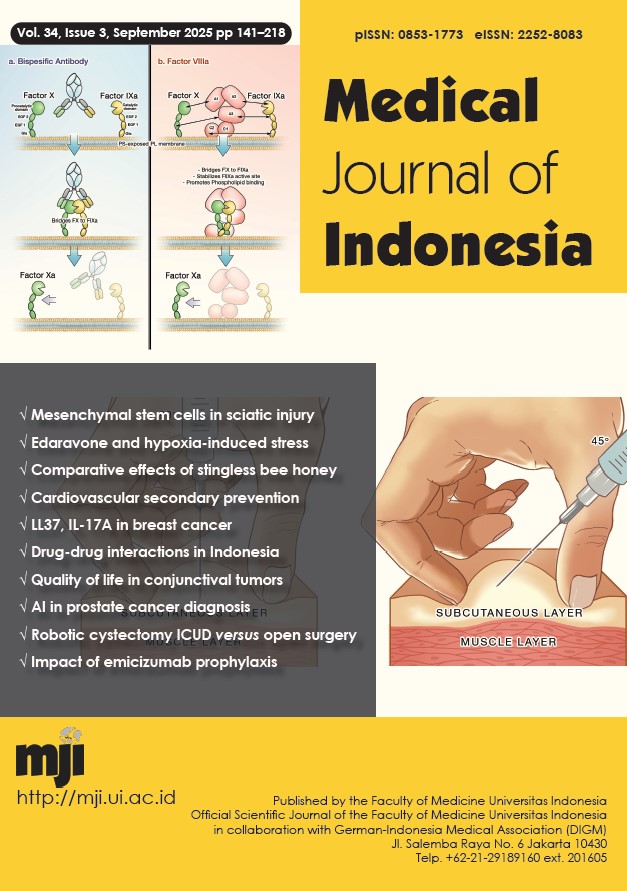Intracranial dural arteriovenous fistula presenting like longitudinally extensive transverse myelitis
DOI:
https://doi.org/10.13181/mji.cr.247543Keywords:
endovascular procedures, dural arteriovenous fistula, transverse myelitisAbstract
Intracranial dural arteriovenous fistula (DAVF) that drains into spinal perimedullary veins can generate longitudinally extensive transverse myelitis (LETM)-like lesion, which often represents a significant diagnostic and therapeutic challenge. This is a case report of a 50-year-old male referred with all extremity weaknesses. Despite receiving high-dose intravenous steroids for suspected myelitis, no improvement was recorded. Spinal imaging showed abnormal hyperintensity extending from the T6 vertebral level to the medulla, and a flow void lesion from the cervicomedullary junction up to the L3 level. Angiography confirmed a Cognard type V spinal DAVF, which was treated with transarterial embolization of the feeding vessel. Follow-up angiography showed complete occlusion of the fistula without any backflow. Flow voids are no longer visible on MRI conducted 3 weeks post-procedure. Unfamiliarity with these disorders often leads to delays in diagnosis and treatment. Therefore, it is essential to consider intracranial DAVF as a differential diagnosis for LETM-like lesions.
Downloads
References
Reynolds MR, Lanzino G, Zipfel GJ. Intracranial dural arteriovenous fistulae. Stroke. 2017;48(5):1424−31. https://doi.org/10.1161/STROKEAHA.116.012784
Newton TH, Cronqvist S. Involvement of dural arteries in intracranial arteriovenous malformations. Radiology. 1969;93(5):1071−8. https://doi.org/10.1148/93.5.1071
Borden JA, Wu JK, Shucart WA. A proposed classification for spinal and cranial dural arteriovenous fistulous malformations and implications for treatment. J Neurosurg. 1995;82(2):166−79. https://doi.org/10.3171/jns.1995.82.2.0166
Cognard C, Gobin YP, Pierot L, Bailly AL, Houdart E, Casasco A, et al. Cerebral dural arteriovenous fistulas: clinical and angiographic correlation with a revised classification of venous drainage. Radiology. 1995;194(3):671−80. https://doi.org/10.1148/radiology.194.3.7862961
Gandhi D, Chen J, Pearl M, Huang J, Gemmete JJ, Kathuria S. Intracranial dural arteriovenous fistulas: classification, imaging findings, and treatment. AJNR Am J Neuroradiol. 2012;33(6):1007−13. https://doi.org/10.3174/ajnr.A2798
Davies MA, TerBrugge K, Willinsky R, Coyne T, Saleh J, Wallace MC. The validity of classification for the clinical presentation of intracranial dural arteriovenous fistulas. J Neurosurg. 1996;85(5):830−7. https://doi.org/10.3171/jns.1996.85.5.0830
De Grado A, Manfredi C, Brugnera A, Groppo E, Valvassori L, Cencini F, et al. Watch brain circulation in unexplained progressive myelopathy: a review of Cognard type V arterio-venous fistulas. Neurol Sci. 2023;44(10):3457−80. https://doi.org/10.1007/s10072-023-06870-1
D'Aliberti G, Talamonti G, Boeris D, Crisà FM, Fratianni A, Stefini R, et al. Intracranial dural arteriovenous fistulas: the sinus and non-sinus concept. Acta Neurochir Suppl. 2021;132:113−22. https://doi.org/10.1007/978-3-030-63453-7_17
Akmangit I, Daglioglu E, Kaya T, Alagoz F, Sahinoglu M, Peker A, et al. Preliminary experience with squid: a new liquid embolizing agent for AVM, AV fistulas and tumors. Turk Neurosurg. 2014;24(4):565−70. https://doi.org/10.5137/1019-5149.JTN.11179-14.0
Gioppo A, Faragò G, Caldiera V, Caputi L, Cusin A, Ciceri E. Medial tentorial dural arteriovenous fistula embolization: single experience with embolic liquid polymer SQUID and review of the literature. World Neurosurg. 2017;107:1050.e1−7. https://doi.org/10.1016/j.wneu.2017.08.050
Iampreechakul P, Wangtanaphat K, Lertbutsayanukul P, Wattanasen Y, Siriwimonmas S. Spontaneous closure of a cavernous sinus dural arteriovenous fistula with spinal perimedullary drainage (Cognard V) during attempted transvenous embolization. Asian J Neurosurg. 2019;14(4):1268−74. https://doi.org/10.4103/ajns.AJNS_277_19
Haryu S, Endo T, Sato K, Inoue T, Takahashi A, Tominaga T. Cognard type V intracranial dural arteriovenous shunt: case reports and literature review with special consideration of the pattern of spinal venous drainage. Neurosurgery. 2014;74(1):E135-42. https://doi.org/10.1227/NEU.0000000000000069
Su X, Zhang P, Ye M. Cognard type V torcular dural arteriovenous fistula: a rare entity. World Neurosurg. 2023;178:132−3. https://doi.org/10.1016/j.wneu.2023.07.092
Whittam D, Huda S, Gibbons E, Pullicino R, Solomon T, Chandran A, et al. A case series of intracranial dural arteriovenous fistulae mimicking cervical myelitis: a diagnosis not to be missed. J Neurol. 2021;268(12):4680−6. https://doi.org/10.1007/s00415-021-10571-0
Hou K, Li G, Qu L, Liu H, Xu K, Yu J. Intracranial dural arteriovenous fistulas with brainstem engorgement: an under-recognized entity in diagnosis and treatment. Front Neurol. 2020;11:526550. https://doi.org/10.3389/fneur.2020.526550
Mustafa R, Passe TJ, Lopez-Chiriboga AS, Weinshenker BG, Krecke KN, Zalewski NL, et al. Utility of MRI enhancement pattern in myelopathies with longitudinally extensive T2 lesions. Neurol Clin Pract. 2021;11(5):e601−11. https://doi.org/10.1212/CPJ.0000000000001036
Cobos Codina S, Bernal García LM, Rodríguez Sánchez JA, Gavilán Iglesias T, de Alarcón LF. Tentorial dural arteriovenous fistula with perimedullary venous drainage-associated cervical myelopathy: illustrative case. J Neurosurg Case Lessons. 2022;4(6):CASE22148. https://doi.org/10.3171/CASE22148
Kim WY, Kim JB, Nam TK, Kim YB, Park SW. Cervical myelopathy caused by intracranial dural arteriovenous fistula. Korean J Spine. 2016;13(2):67−70. https://doi.org/10.14245/kjs.2016.13.2.67
Rathnam AS, Memon AB. Foix-Alajouanine syndrome mimicking longitudinally extensive transverse myelitis. Eur J Case Rep Intern Med. 2020;7(12):002063. https://doi.org/10.1212/WNL.94.15_supplement.5569
Letourneau-Guillon L, Cruz JP, Krings T. CT and MR imaging of non-cavernous cranial dural arteriovenous fistulas: findings associated with cortical venous reflux. Eur J Radiol. 2015;84(8):1555−63. https://doi.org/10.1016/j.ejrad.2015.04.019
Jermakowicz WJ, Weil AG, Vlasenko A, Bhatia S, Niazi TN. Cognard type V intracranial dural arteriovenous fistula presenting in a pediatric patient with rapid, progressive myelopathy. J Neurosurg Pediatr. 2017;20(2):158−63. https://doi.org/10.3171/2017.3.PEDS16363
Kim J, Kim BM, Park KY, Lee JW, Kim YB, Chung J, et al. Angioarchitectural analysis of arteriovenous shunts in dural arteriovenous fistulas and its clinical implications. Neurosurgery. 2022;91(5):782−9. https://doi.org/10.1227/neu.0000000000002121
Sim SY. Pathophysiology and classification of intracranial and spinal dural AVF. J Cerebrovasc Endovasc Neurosurg. 2022;24(3):203−9. https://doi.org/10.7461/jcen.2022.E2021.04.001
Abdelsadg M, Kanodia AK, Keston P, Galea J. Unusual case of intracranial dural AV fistula presenting with acute myelopathy. BMJ Case Rep. 2016;2016:bcr2016215227. https://doi.org/10.1136/bcr-2016-215227
Published
How to Cite
Issue
Section
License
Copyright (c) 2025 Nia Yuliatri, Ingrid Ayke Widjaya, Gibran Aditiara Wibawa, Alphadenti Harlyjoy, Satyanegara

This work is licensed under a Creative Commons Attribution-NonCommercial 4.0 International License.
Authors who publish with Medical Journal of Indonesia agree to the following terms:
- Authors retain copyright and grant Medical Journal of Indonesia right of first publication with the work simultaneously licensed under a Creative Commons Attribution-NonCommercial License that allows others to remix, adapt, build upon the work non-commercially with an acknowledgment of the work’s authorship and initial publication in Medical Journal of Indonesia.
- Authors are permitted to copy and redistribute the journal's published version of the work non-commercially (e.g., post it to an institutional repository or publish it in a book), with an acknowledgment of its initial publication in Medical Journal of Indonesia.






































